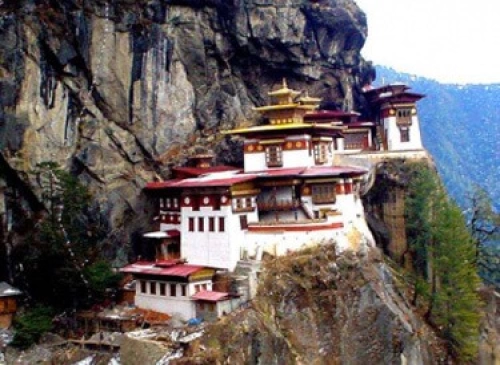Bhutan is a mystical kingdom where time ceases to exist, where lamas can live for hundreds of years, where reincarnation is a part of life and no one measures their life by years. In this tiny Himalayan kingdom, life is measured by seasons, festivals and Gross National Happiness. Bhutan is a beautiful, surreal place where fluttering colorful prayer flags decorate the landscape everywhere just as Buddhism colors every facet of life.
The sentry-like Himalaya kept Bhutan protected from the outside world for generations. Except for the invited guests of the royal family, outsiders knew little about this hidden Shangri La of blue skies, snow-capped mountains, ancient monasteries and tantric Buddhism. Since 1974, tourists are welcome in the ‘Land of the Thunder Dragon’, or Druk Yul, as it is known as in Bhutanese. But until now, the numbers have been minimal, which means that the environment, religion, culture and traditions have remained almost entirely uninfluenced by the modern world.
The history of Bhutan recounts astonishing legends of mystical reincarnations and magical transformations of deities and demons. It is quite fitting that Bhutan’s only international airport is in Paro where, according to legend, the Great Guru Rinpoche arrived from northeast Bhutan, flying on the back of a tigress in 747 AD. The famous ‘Tiger’s Nest Monastery’, perched on a cliff 900 meters above the Paro Valley, was built at the cave where Guru Rinpoche meditated, and brought Tantric Buddhism to Bhutan. As well as being the most sacred Buddhist site in Bhutan, it is a breathtaking sight to admire and marvel at the effort of its construction.
This hermit kingdom was still without roads, currency, telephones, hospitals, or schools outside of monasteries in the 1960s. Despite the arrival of modern amenities over the last few decades, most people lives have barely changed in pace or style. Bhutanese villagers still plow with oxen, grow their own food and cook it over a fire in dark smoky kitchens, milk cows, churn butter, spin yarn, distill barley for the local alcohol, and walk for hours or days on mountain footpaths just to reach the nearest village, just as they have done for centuries.
In effort to preserve traditional values, the government of Bhutan enforces a dress code; in public males must wear the kimono-like ‘gho’, and females wear the elegant, ankle-length ‘kira’. There's also a ban on non-traditional forms of architecture. Native Dzongka-style architecture still graces every building.
Tourism in Bhutan:
Tourists receive a warm welcome in Bhutan. There is a tourist tariff, currently set at $250 per person per day, which includes everything you will need; transportation, comfortable accomodation, meals, camping equipment and camping logistics and a guide speaking fluent English .This flat minimum rate has been imposed by the government of Bhutan for two purposes. Bhutan wants to preserve their unique 'other-worldly' environment, which would soon be altered by an 'wide-open door' to tourists.This fee also standardizes the high quality service that the visitors receive. Luxury packages are also available at higher rates.
